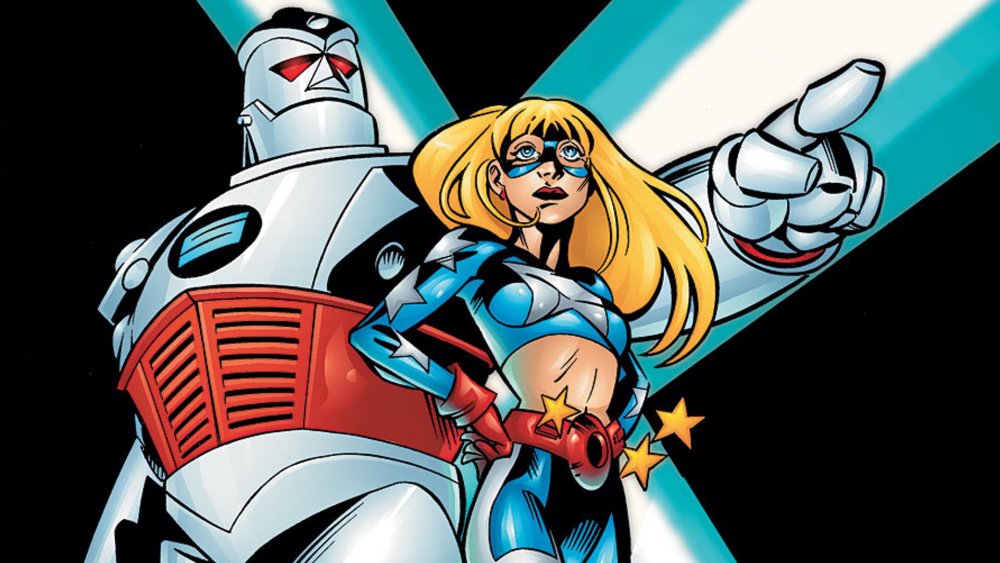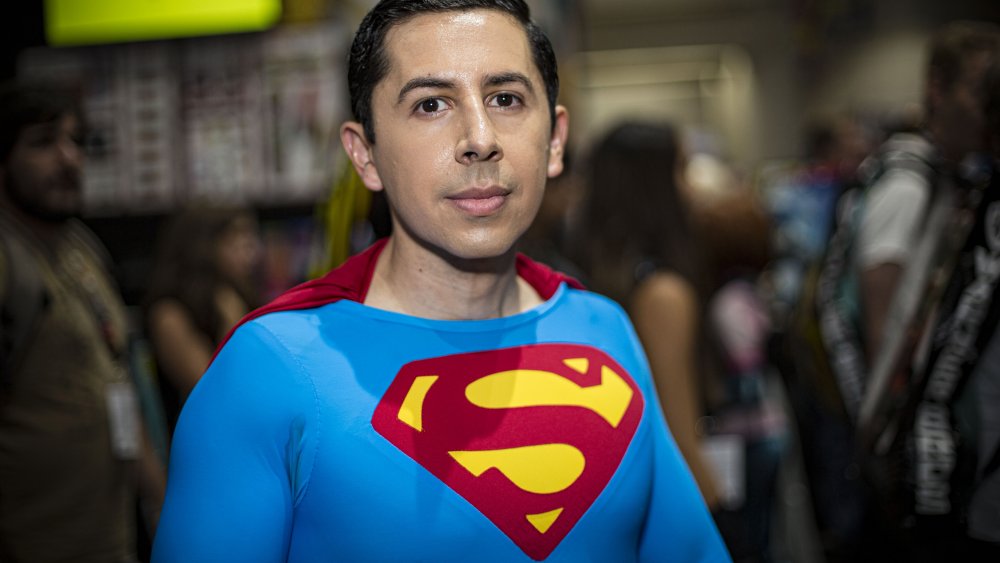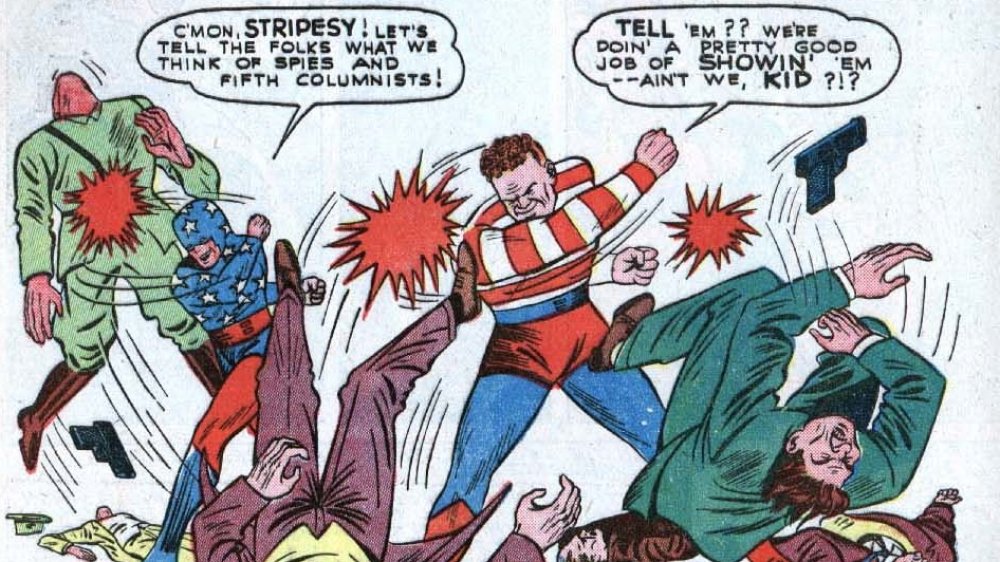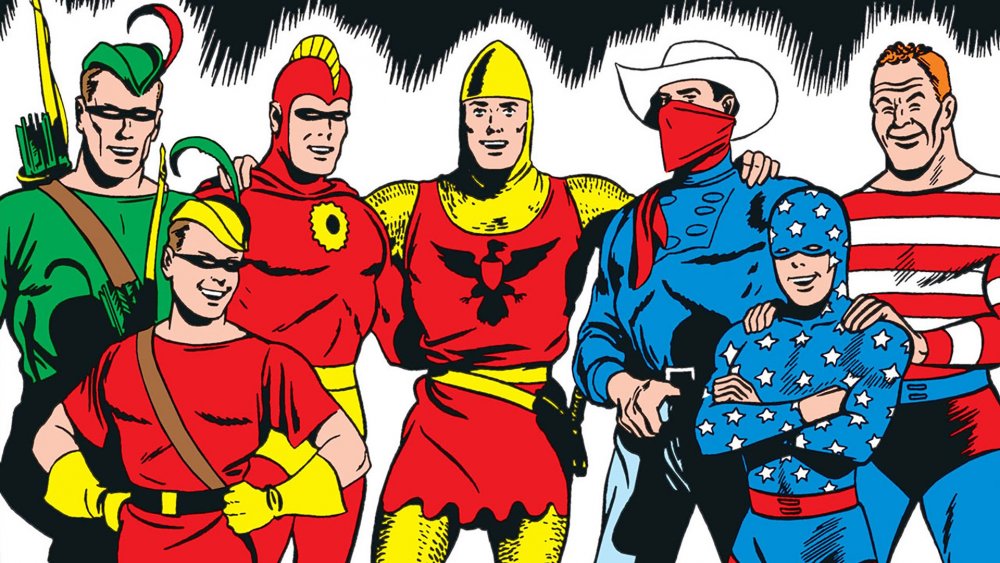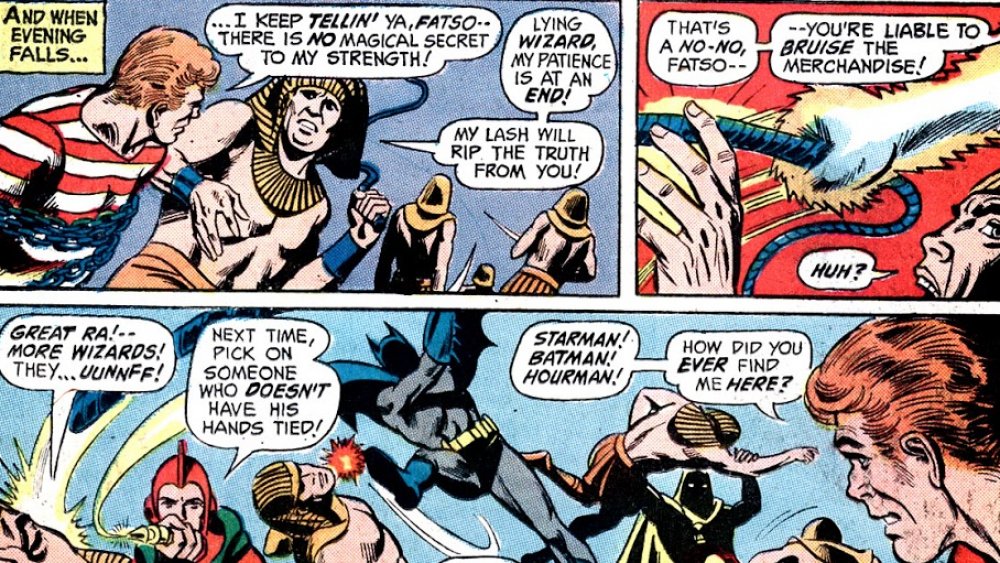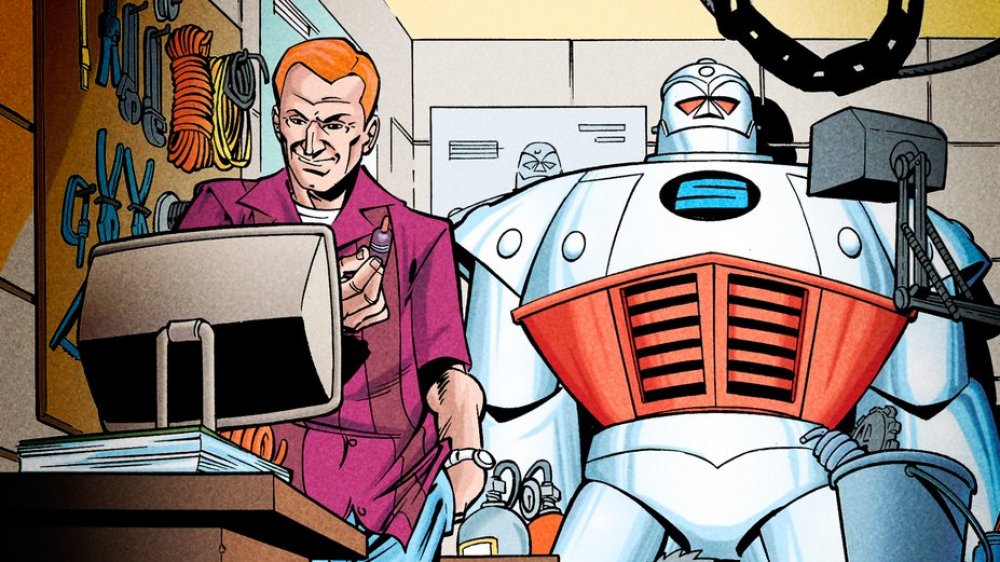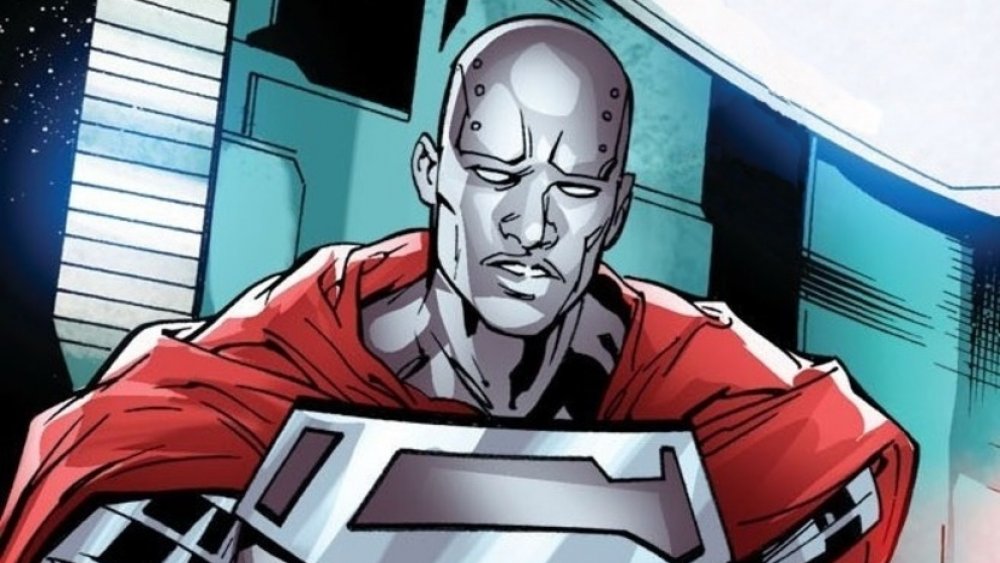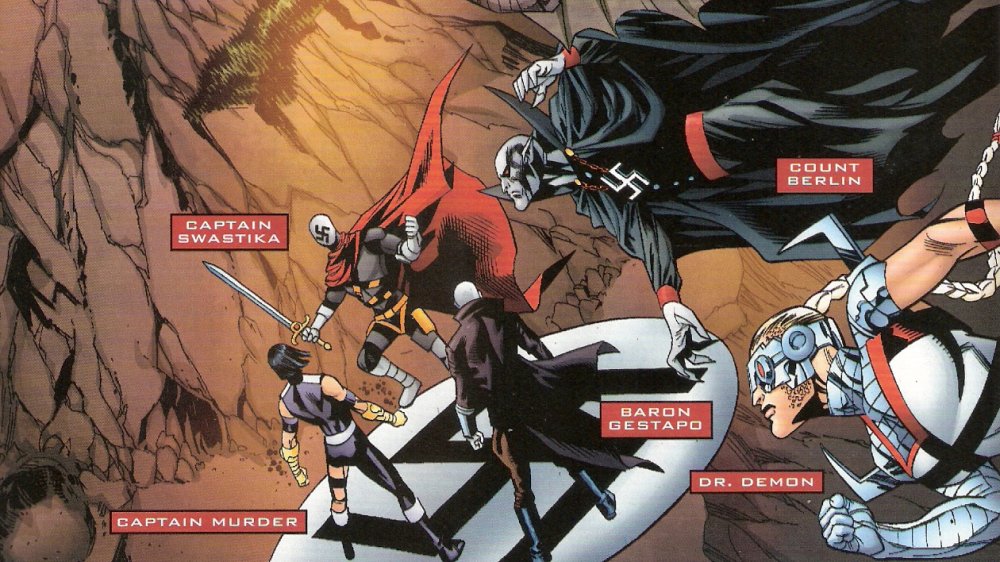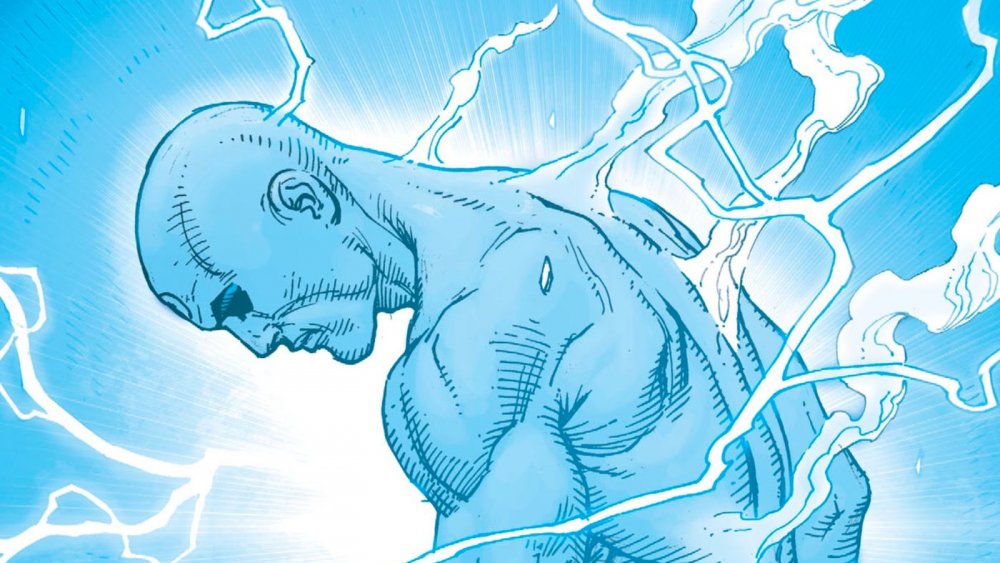The History Of DC's Superhero S.T.R.I.P.E. Explained
The wide world of DC TV shows encompasses everything from musical episodes in which Supergirl belts out ballads to stories involving supernatural detective John Constantine. In this, these shows are much like the superhero comics they spring from: Bold, strange, wide-ranging, and delightfully weird. This four-color feel distinguishes these productions among the often dark and stormy landscape of other superhero media — much of it also drawn from DC Comics. Here, in the world of live-action DC TV shows, the universe is, well, a universe, containing every flight of fancy possible, plus a whole lot of wonderful Easter eggs for all the comic book obsessives tuning in.
The superhero S.T.R.I.P.E., now more widely known than ever before due to his prime position as part of the Stargirl ensemble, is a great example of this free-ranging ethos. The armored fighter, who has his roots in the Golden Age of comics, has been many things over the course of his history — chauffeur, Nazi-fighter, devoted dad — and we're here to explore them all. This is everything you need to know about S.T.R.I.P.E., from his earliest adventures to his time in suburbia.
Here in the real world
S.T.R.I.P.E. is the creation of one of the most famous minds in all of comic book history: The one and only Jerry Siegel, in collaboration with stalwart artist Hal Sherman. If that rings a bell, it's because Siegel was the co-creator, along with artist Joe Shuster, of Superman, and thus the co-creator of the modern superhero. S.T.R.I.P.E. made his debut in 1941's Star Spangled Comics #1, albeit under a different name. He wasn't S.T.R.I.P.E. at this point, but Stripesy. The man beneath the bold costume was Pat Dugan, a remarkably regular dude with a strong right hook.
The all-caps acronym would come later — it stands for Special Tactics Robotic Integrated Power Enhancer — as would the armor. Don't let that fool you into believing the character was anything but attention-grabbing in this initial outing, however. Even at this early stage (in both the character's history and the history of the genre), Siegel was subverting established norms: Stripesy, a grown man, debuted as the sidekick of a crime-fighting child.
The rich kid and the chauffeur
Pat Dugan falls into the role of crime-fighter entirely by accident. Though he does sport a brawler's build, his origin is remarkably out of place in a superhero story. He doesn't gain powers from a toxic waste spill on the docks. He never witnesses a murder by mafia types in an art deco factory that manufactures shadows. Dugan begins, quite simply, as the chauffeur of a rich kid named Sylvester Pemberton, who decides to head out into the world of Nazis, saboteurs, and gangsters, and see what he can do to thwart evil with his own two fists (and a whole lot of money).
Together, they embody the American flag, Sylvester being the stars as the Star-Spangled Kid, Pat being the stripes as Stripesy. With fisticuffs, gadgets, and a whole lot of one-liners, they take on ne'er-do-wells of all sorts. Pat often acts as a sort of enforcer — Sylvester can hold his own, but when a serious beat down needs to be delivered, he summons Pat with a special whistle. Pat also serves as mechanic of the duo's sleek Star Rocket Racer, which, being a Golden Age super car, is tricked out with every possible doo-dad, and can fly as both a rocket and a helicopter.
American hero
The Star-Spangled Kid and Stripesy are a solid enough duo on their own: Star Spangled Comics contains dozens of stories of the pair's adventures that still delight to this day. But apparently, DC felt their were missing something — or perhaps that their unique attributes would be best highlighted in a group setting. Whatever the reason, the Star-Spangled Kid and Stripesy went from being a double act to part of a full-blown team as part of the Seven Soldiers of Victory.
Debuting in 1941's Leading Comics #1, the Seven Soldiers are a classic super-team, who have gone on to pop up all over the DC canon. Joining the Star-Spangled Kid and Stripesy are the Crimson Avenger, the Vigilante, Green Arrow, Speedy, and the Shining Knight. They are often also joined by Wing, the Crimson Avenger's sidekick. Uniquely, the Seven Soldiers contain multiple sidekicks — Speedy, Stripesy, and Wing — and have very few true super powers between them. But of course, they don't need them — American grit and two-fisted justice are the order of the day for the Seven Soldiers.
The Star-Spangled Kid and Stripesy enjoy plenty of adventures as members of the Seven Soldiers of Victory. But they fall off the radar, along with the rest of their crew, after they take on the fiendish Nebula Man.
Rough patch
In the real world, the Seven Soldiers fell off the radar after the Golden Age. In-universe, however, DC came up with an intriguing explanation for the super-team's vanishing act, explored in 1972's Justice League of America #100: The team was scattered throughout human history by the enormously powerful Nebula Man. The Star-Spangled Kid and Stripesy were deposited in ancient Egypt — a terrifying prospect to be sure, but not as bad as most. Speedy, for example, had been tossed into ancient Greece, and is discovered to have been transformed into a centaur by Circe, legendary witch of the Odyssey.
After the Justice League recovers the lost Seven Soldiers, Pat stumbles into a bit of a rough period in his life. While he didn't age during his time-displaced travels, the world has moved on without him. While he is able to settle down and start a family, it soon falls apart: His wife Maggie leaves him and takes their son, Michael. The patents for his inventions had also been stolen while he was lost in time, taken over by the Star-Spangled Kid's cad uncle, Arthur.
At the same time, Sylvester is on his way up. He becomes the cosmically-themed hero Skyman and joins the JSA. Sylvester does manage to return Dugan's patents to him, before being killed by the Injustice Society.
Family man
Pat Dugan retreats entirely from the superhero business at this point. He gets married again, and gains a stepdaughter named Courtney Whitmore. Dugan is cagey about his time as a crimefighter, which leads Courtney to rebel against him by picking up the Star-Spangled Kid mantle. She becomes Stargirl, wielding Sylvester's old Cosmic Converter Belt, and forces Pat back into action. To keep up with the young man's game of superpowered slugfests, Dugan builds a massive metal exoskeleton for himself called S.T.R.I.P.E., standing for Special Tactics Robotic Integrated Power Enhancer. Thus empowered, he joins Stargirl on her new adventures, which start in the bright, bold pages of 1999's Stars and S.T.R.I.P.E. #0.
It's a whole new set-up for the man once known as Stripesy, and yet a very familiar one: Here he is again, standing by a kid with big dreams of changing the world. Although he's a little more careful than he used to be, especially in the wake of Sylvester's death, he's as staunch a defender of good as he's always been, and a great partner for Stargirl.
Moving to Metropolis
Given Stripesy's real-world connection to the Man of Steel and his frequent dalliances with the Justice Society of America, it only makes sense that he eventually ends up in Metropolis. Pat and his family move to Supes' home turf following 1999's "Day of Judgment" event. There, Pat meets and lends a hand to the hero whose skill set most closely mirrors his own: Steel, AKA John Henry Irons.
Like Pat, Irons uses his proficiency with machinery to build himself a massive metal suit. Pat built his suit to protect his stepdaughter, but Irons built his to protect Metropolis in the wake of Superman's apparent death at the hands of Doomsday. The city needed a protector, and so Irons made himself into one: His suit even replicates Superman's powers. Once Superman returns, Steel keeps fighting alongside the man who inspired him. While in Metropolis, S.T.R.I.P.E. fights alongside Steel in a match-up that feels practically ordained by the comic book gods. Eventually, however, Pat and his family move back to Blue Valley and Pat resumes he work with Stargirl.
Nazis redux
In the world of comic books, no hero is ever truly gone. Characters return from the dead on a regular basis. Old, forgotten characters are revived by new writers. Vanquished villains creep back after years of silence. This even proves true of the Nazis that Pat Dugan began his career fighting.
A super-powered league of neo-Nazis called the Fourth Reich emerges in the pages of 2007's Justice Society of America series. Led by Captain Nazi, they hope to destroy all of the relatives and descendants of Golden Age patriotic heroes. This puts Pat Dugan and Courtney square in their cross hairs. While they are able to knock off the families of Minute-Man, Mister America, and Commander Steel, the Justice Society of America intervenes on behalf of their old friend and ally, bringing the criminal group to justice. Pat and his family escape unscathed, if rattled — and who could blame them? Dude has had to endure direct Nazi attacks twice in his life. To thank the JSA for their help, he invites them all to Courtney's birthday party ... and wins serious points with Courtney by presenting her with her very own iPhone.
Other timelines
Because comic book universes never stay simple or linear, there are several other timelines in which Pat Dugan has enjoyed some very different adventures. DC's 2011 New 52 reboot makes Dugan's connection to Stargirl a little less formal, as he's merely her mother's boyfriend here, rather than her husband. Instead of picking up the Star-Spangled Kid gig as a way to irritate her stepfather, Courtney stumbles into the role entirely by accident. She finds Sylvester's old outfit and gear while cleaning out Pat's office. She dons them, becomes Stargirl, and thwarts crime — all of it caught on video which goes viral. Pat agrees to train her in the wake of this excitement.
2017's Doomsday Clock, a series which braids together the New 52, the DC Rebirth event, and Watchmen, does something entirely different with Pat's history. This run sees Pat's work in the Justice Society of America erased by Doctor Manhattan ... and then reinstated by him. The omnipotent blue being winked the whole era of Golden Age superheroes out of existence, only to be convinced to reverse it by Superman.
Taking on the small screen
The Stargirl TV series appears to follow a similar path as the pre-New 52 DC canon. In this show, Pat, played by Luke Wilson, was once a hired hand for a rich kid named Sylvester Pemberton. The time travel subplot appears to have been excised, with Pat leaving crime-fighting without being tossed into ancient Egypt. Similar to other iterations of the character, he distances himself from superheroes after Sylvester is killed — and is forced back into the crusader's life when it become clear that the Injustice Society is still active.
The first season of the series received major praise, and a second season has been announced. Though no details about the direction of the series are available currently, it will air exclusively on The CW. This breaks with the former release model, in which Stargirl was released on both The CW and the DC Universe platform.
